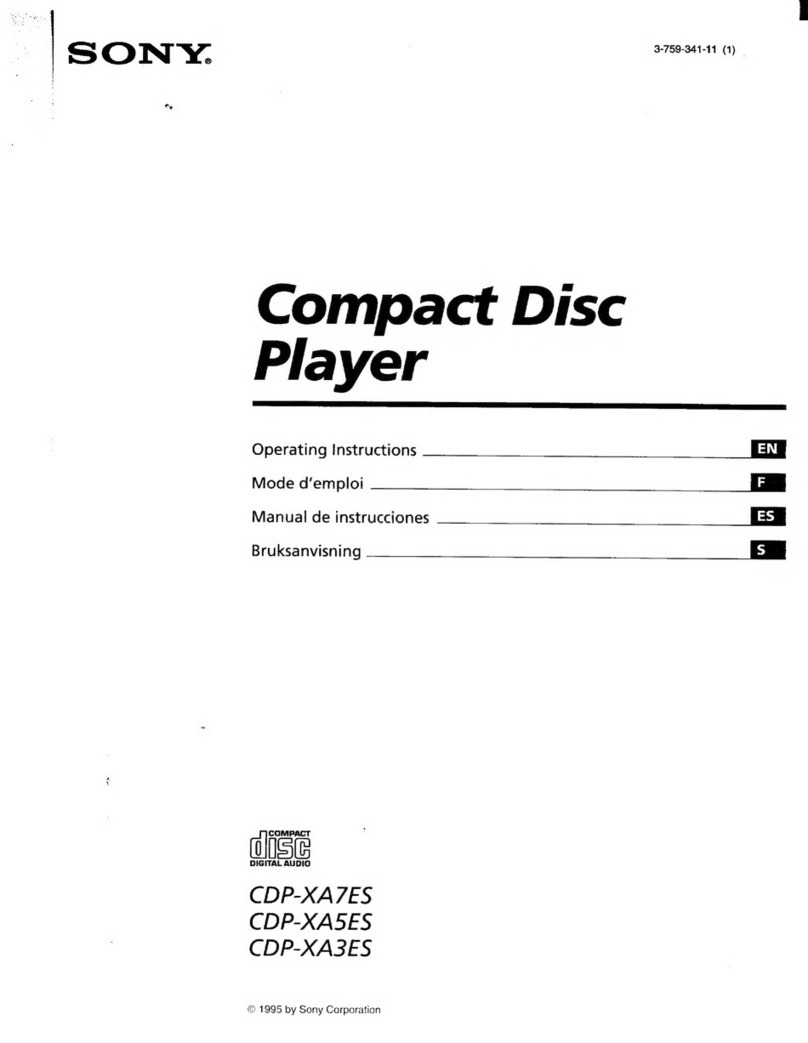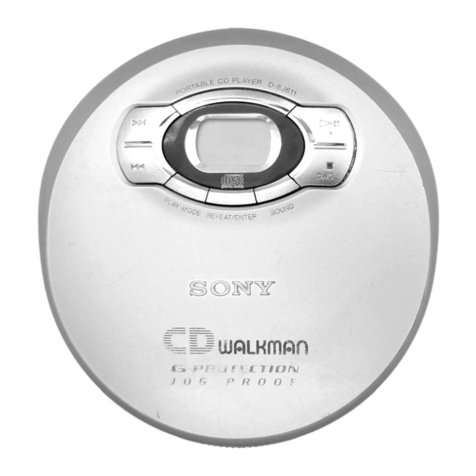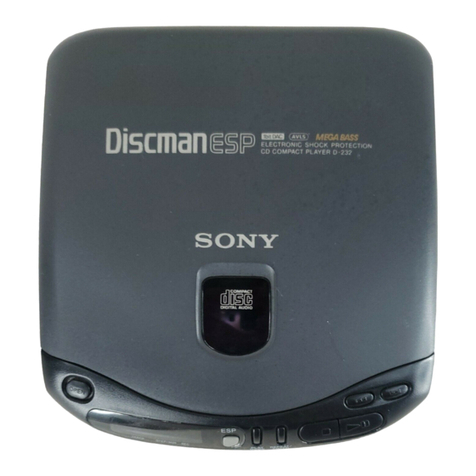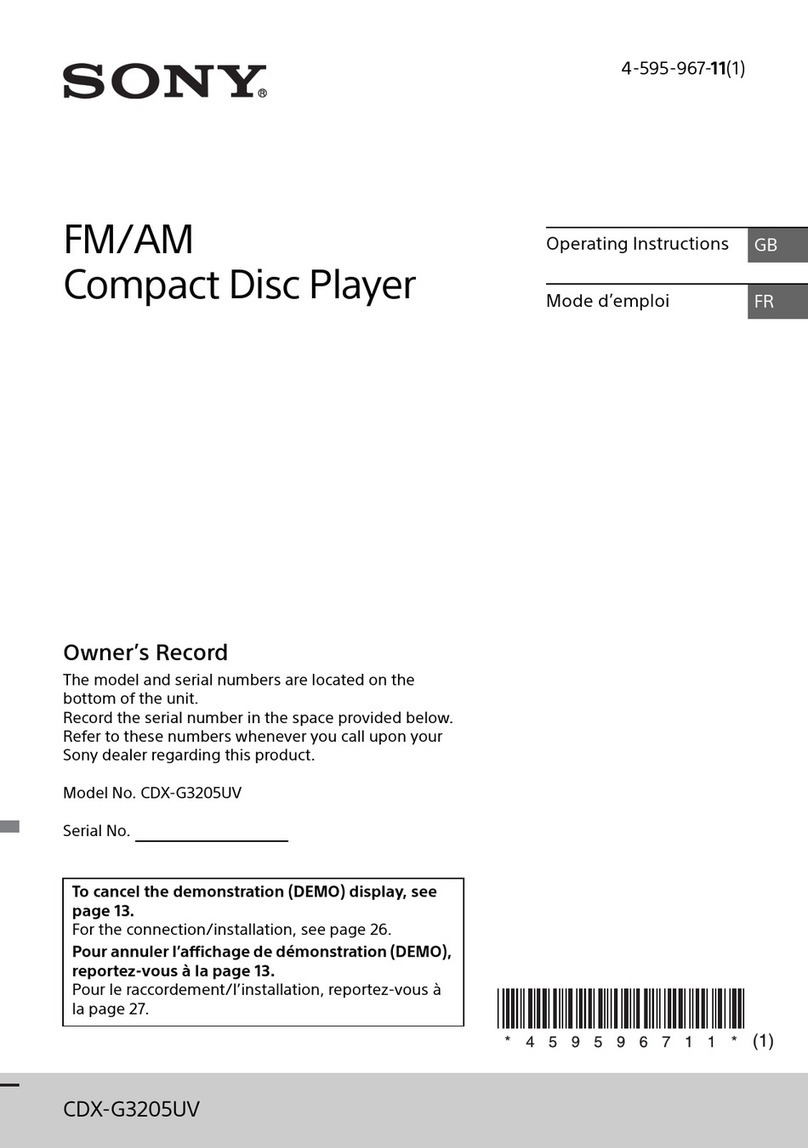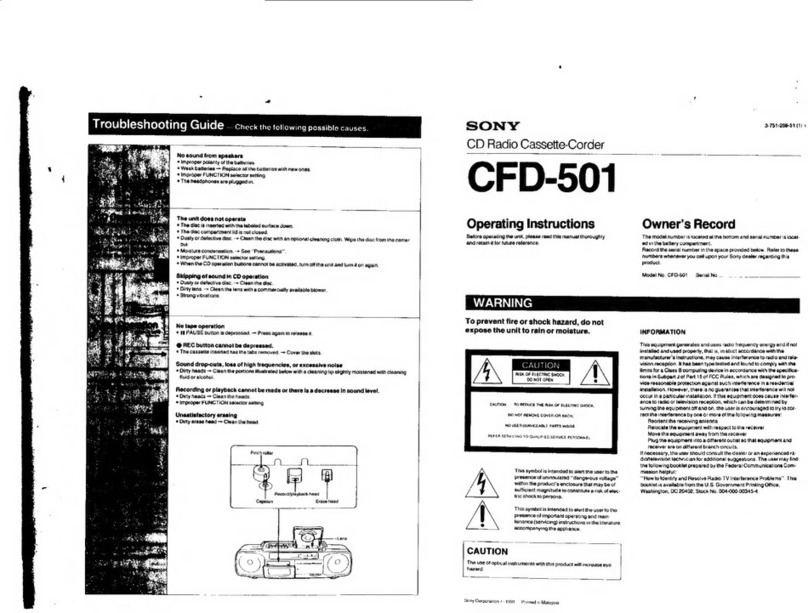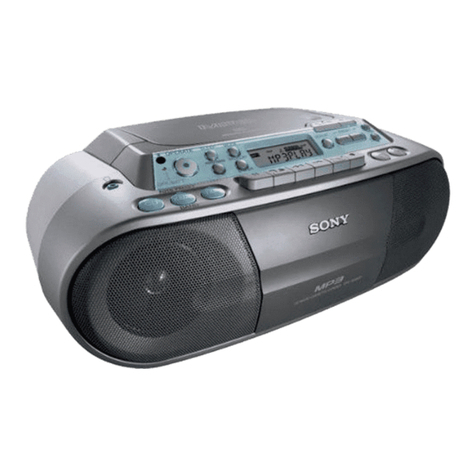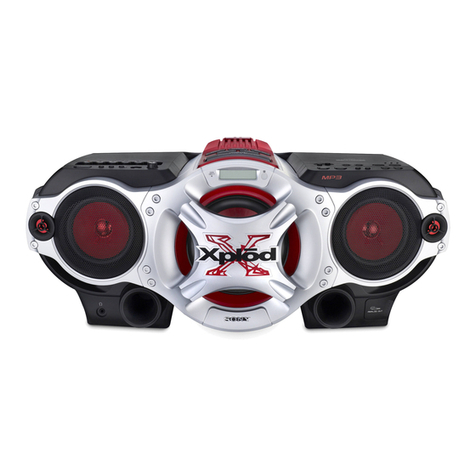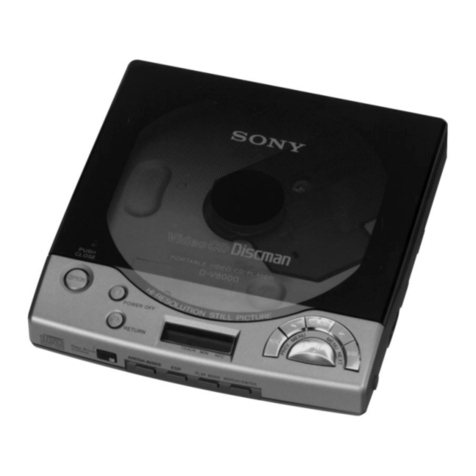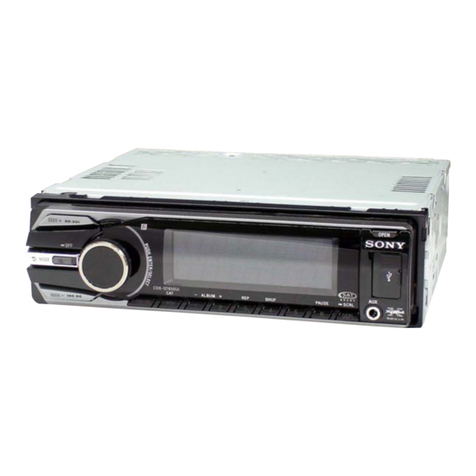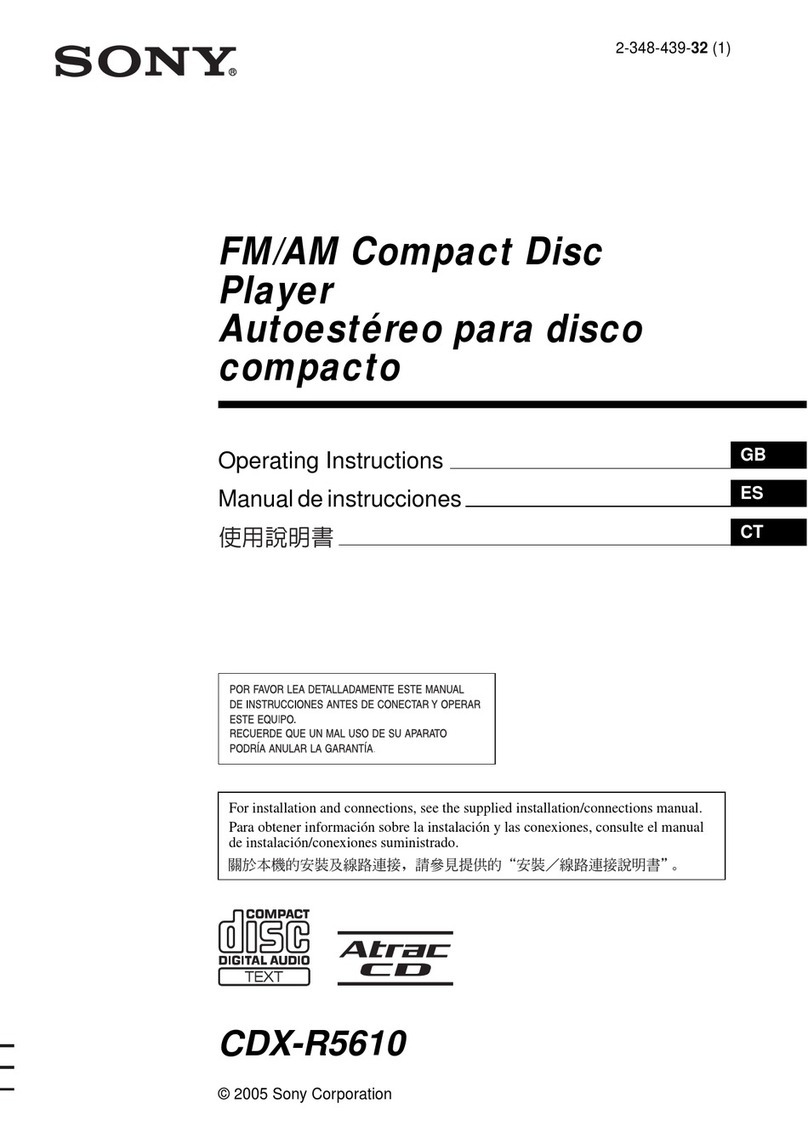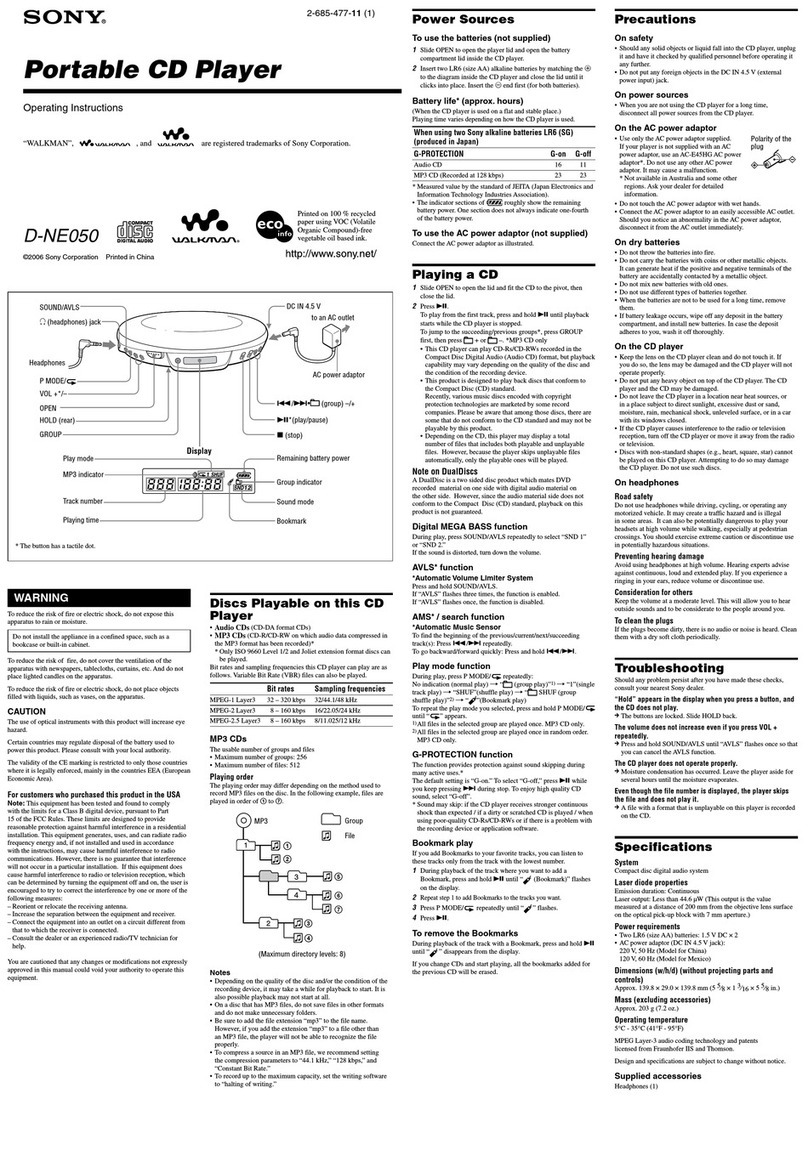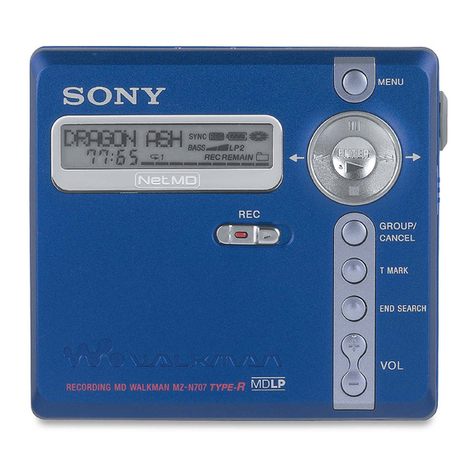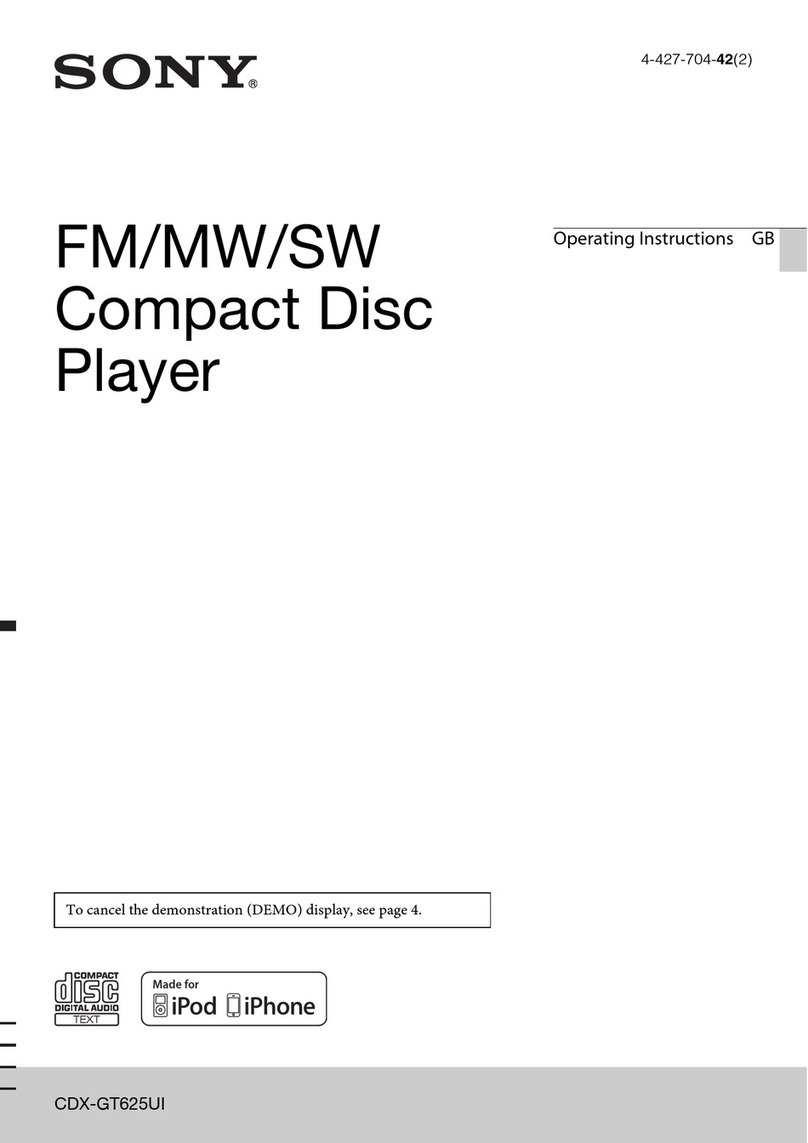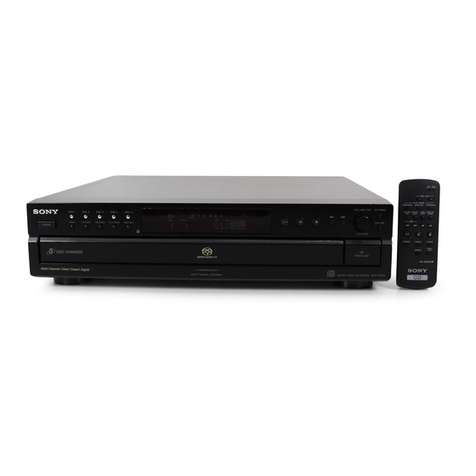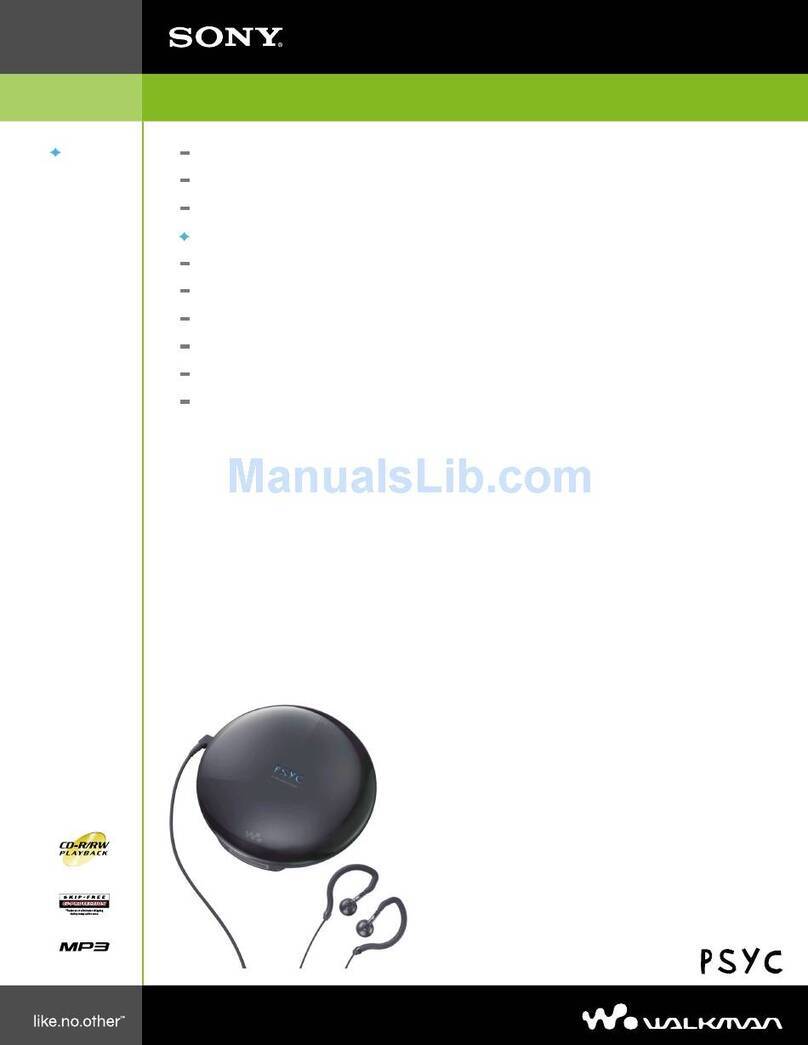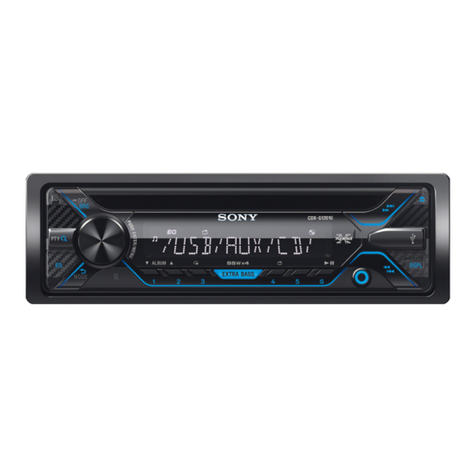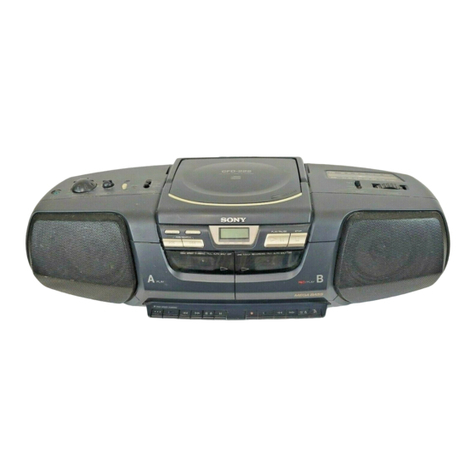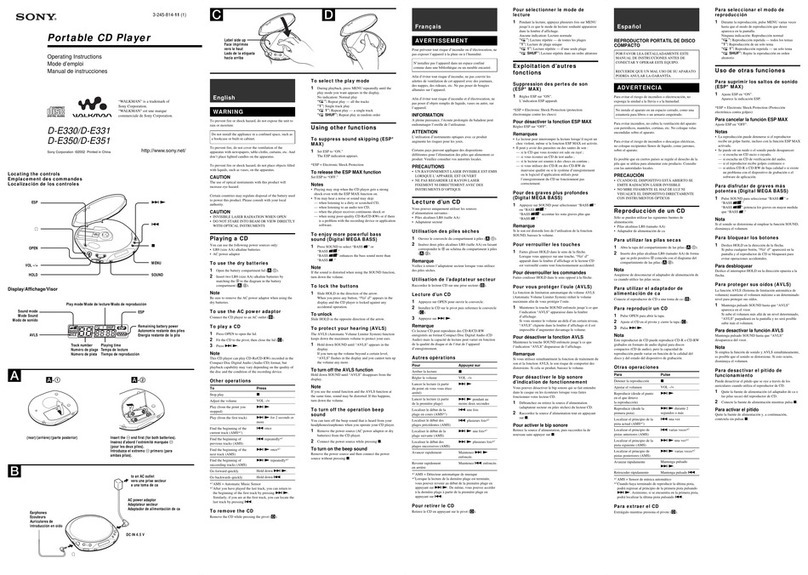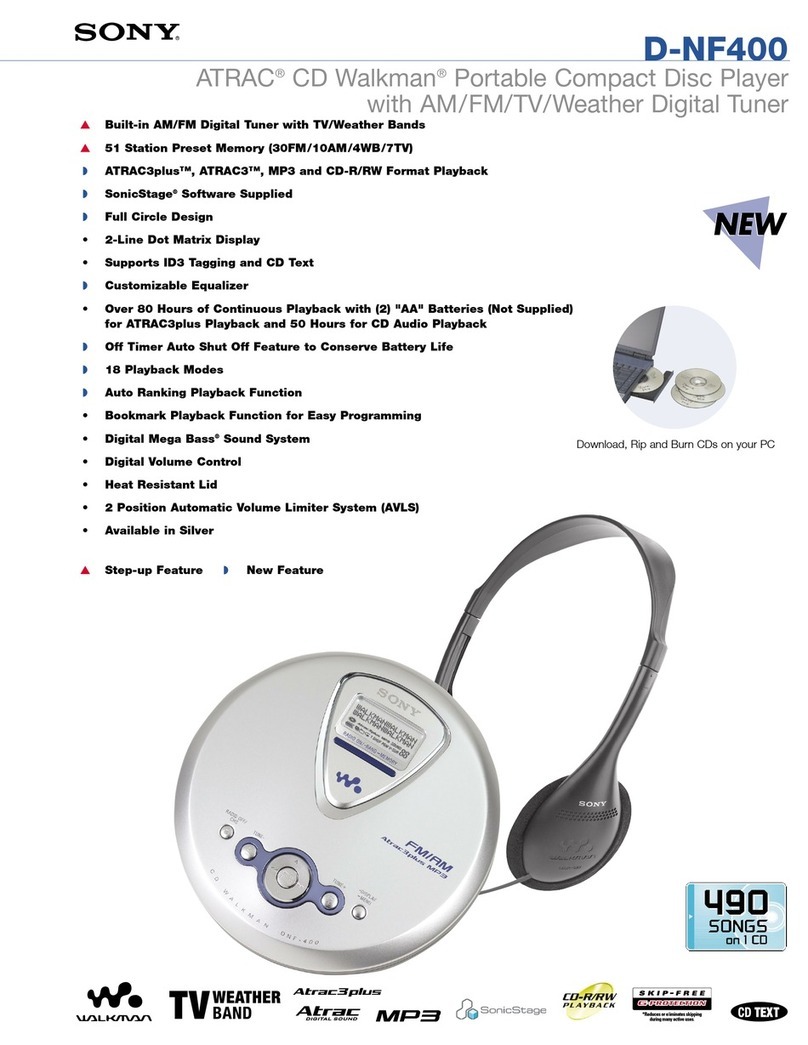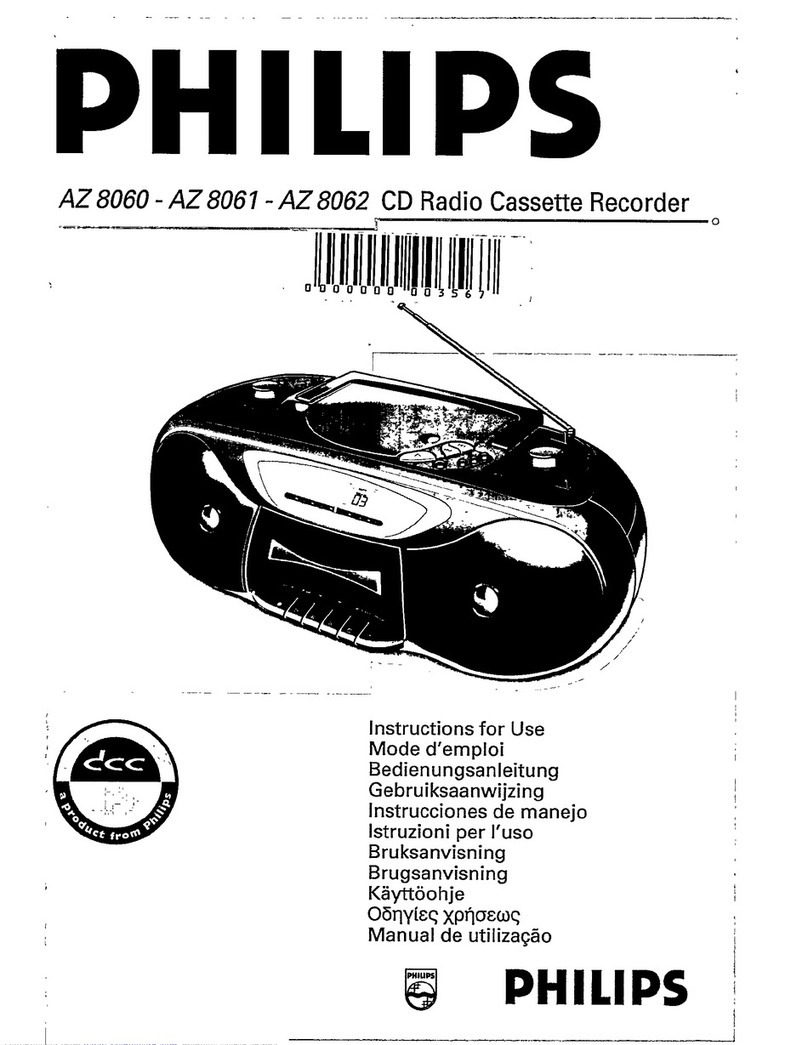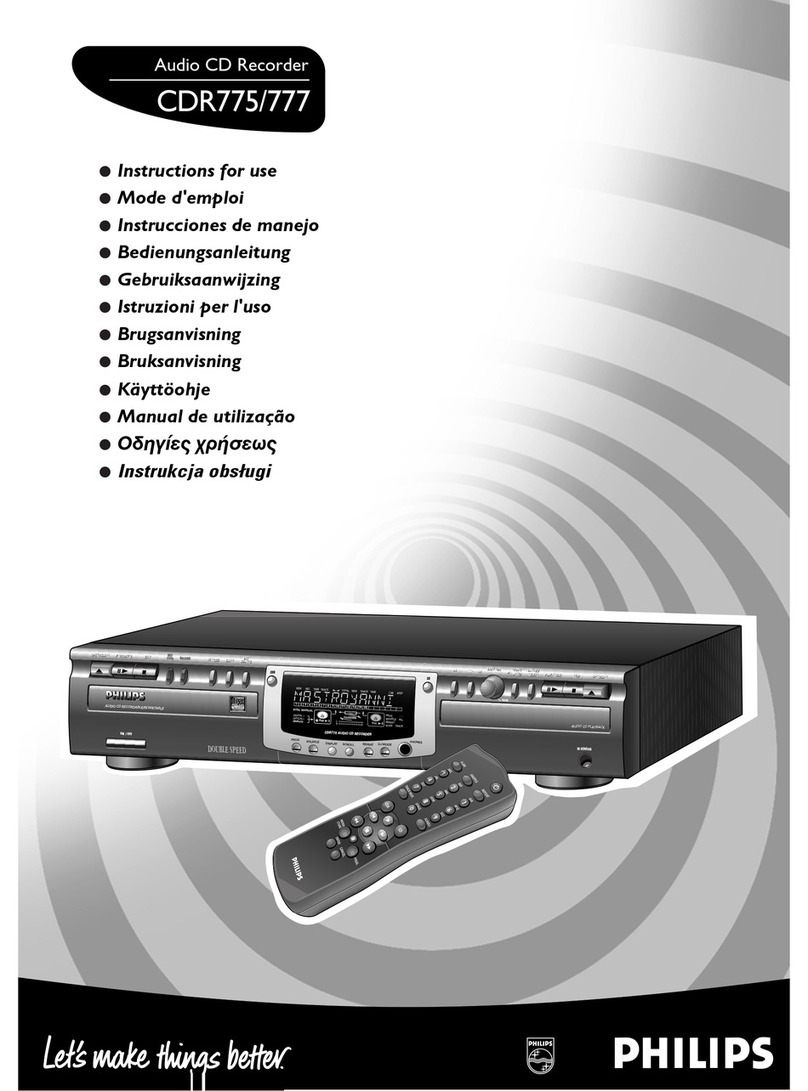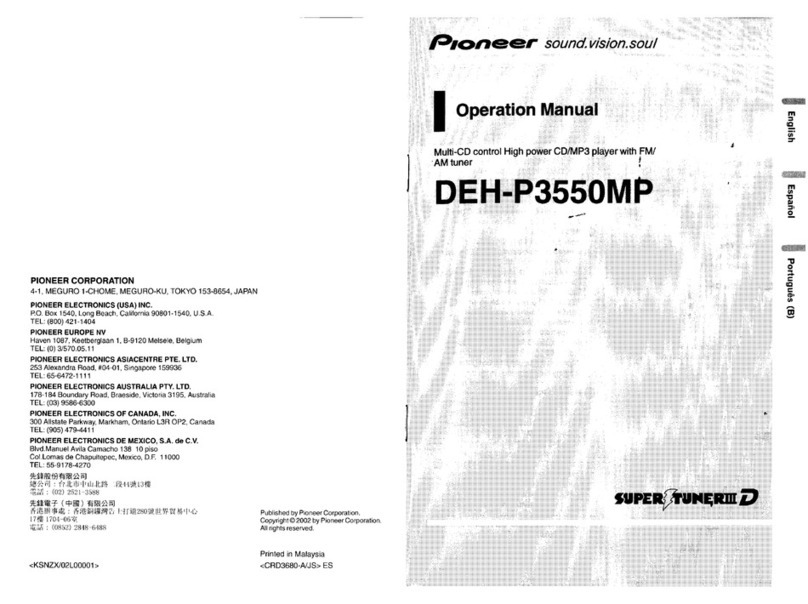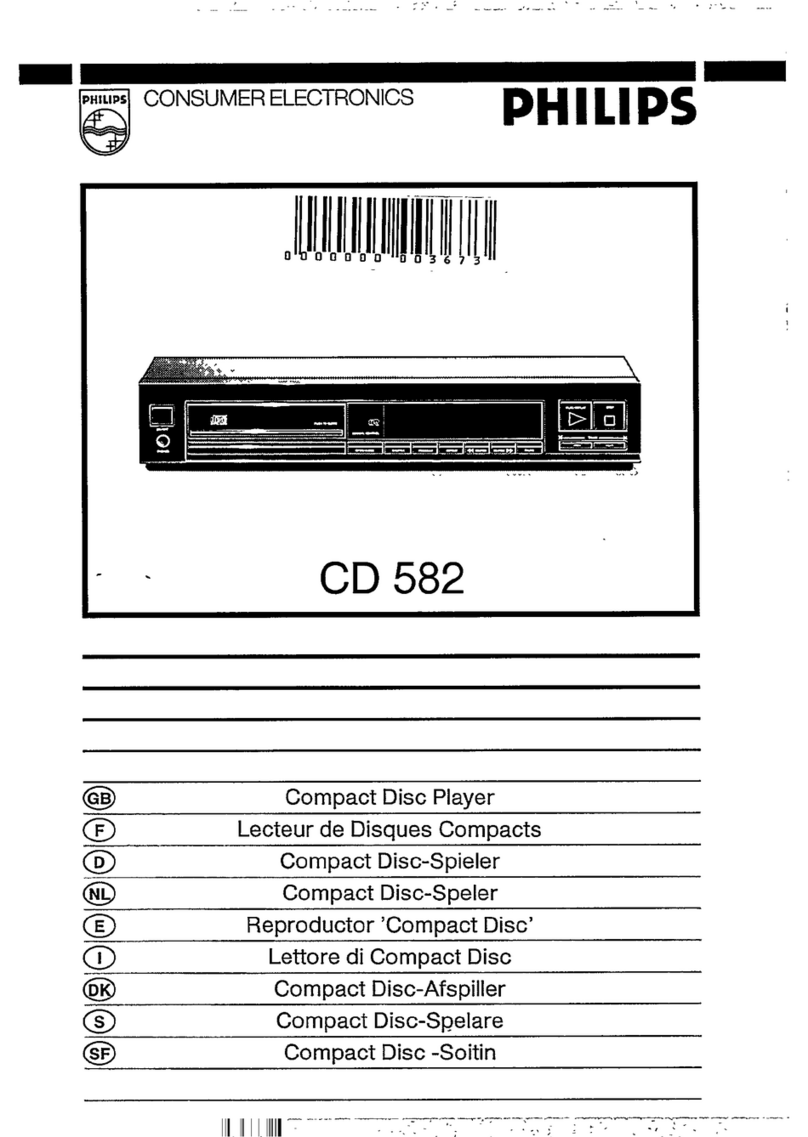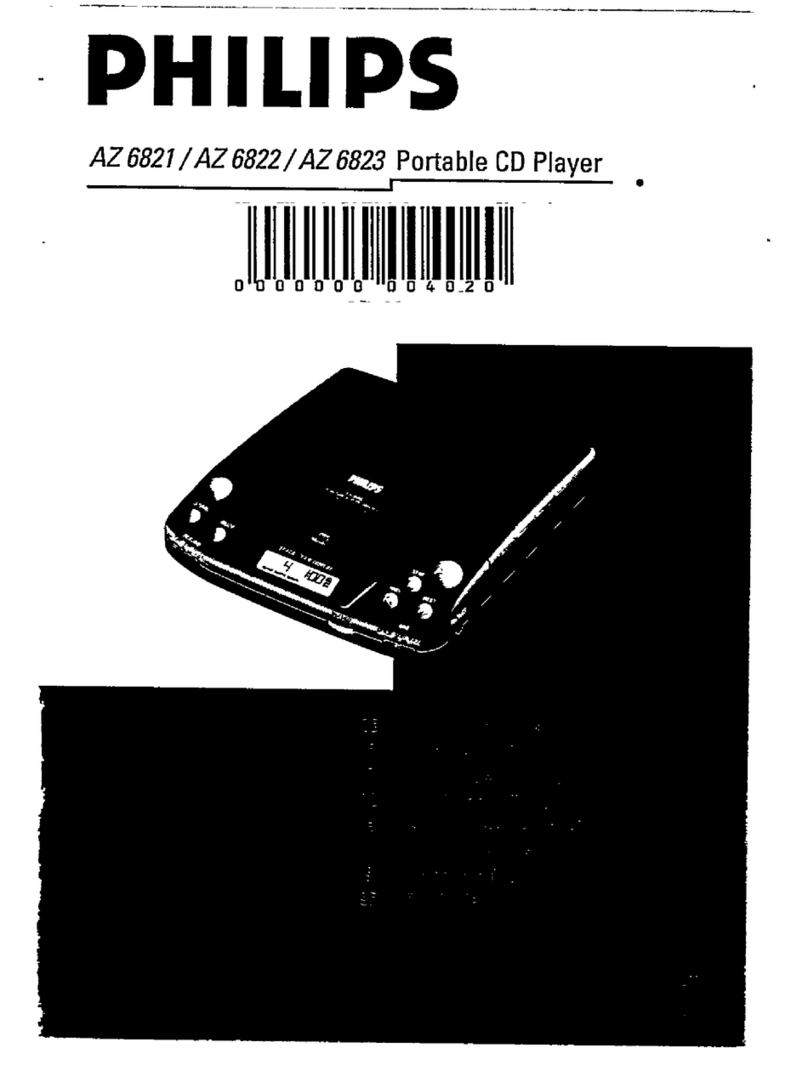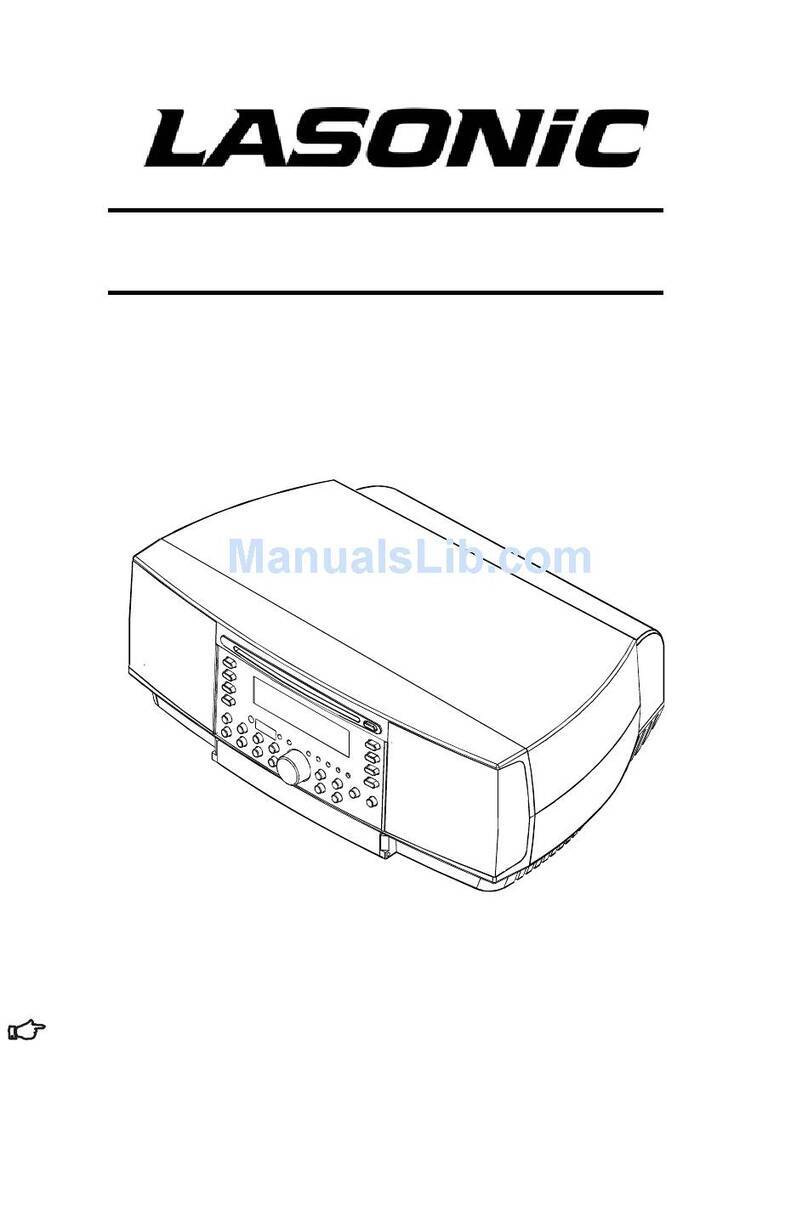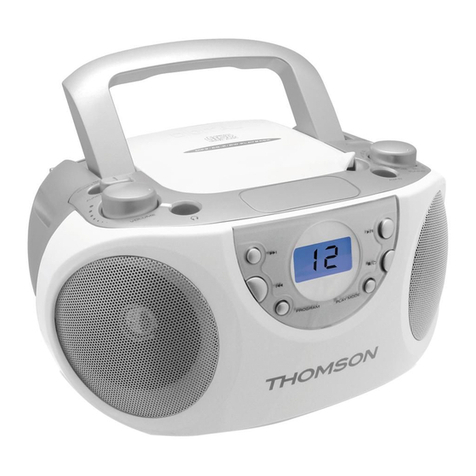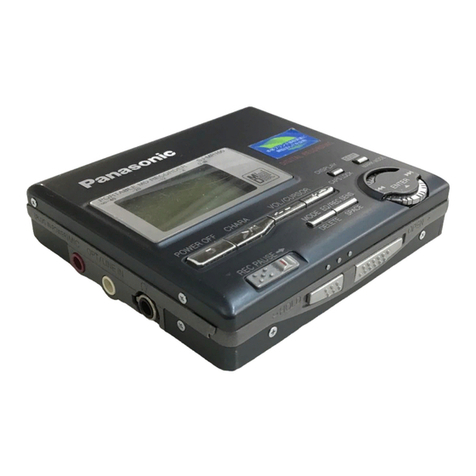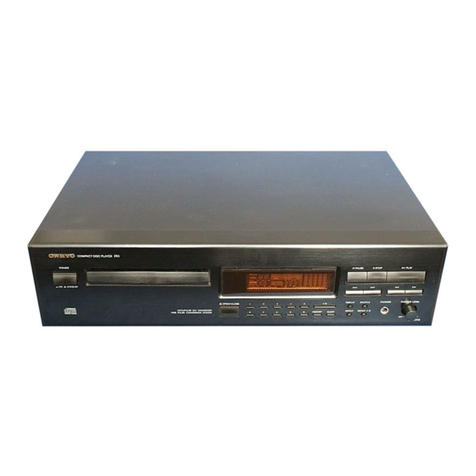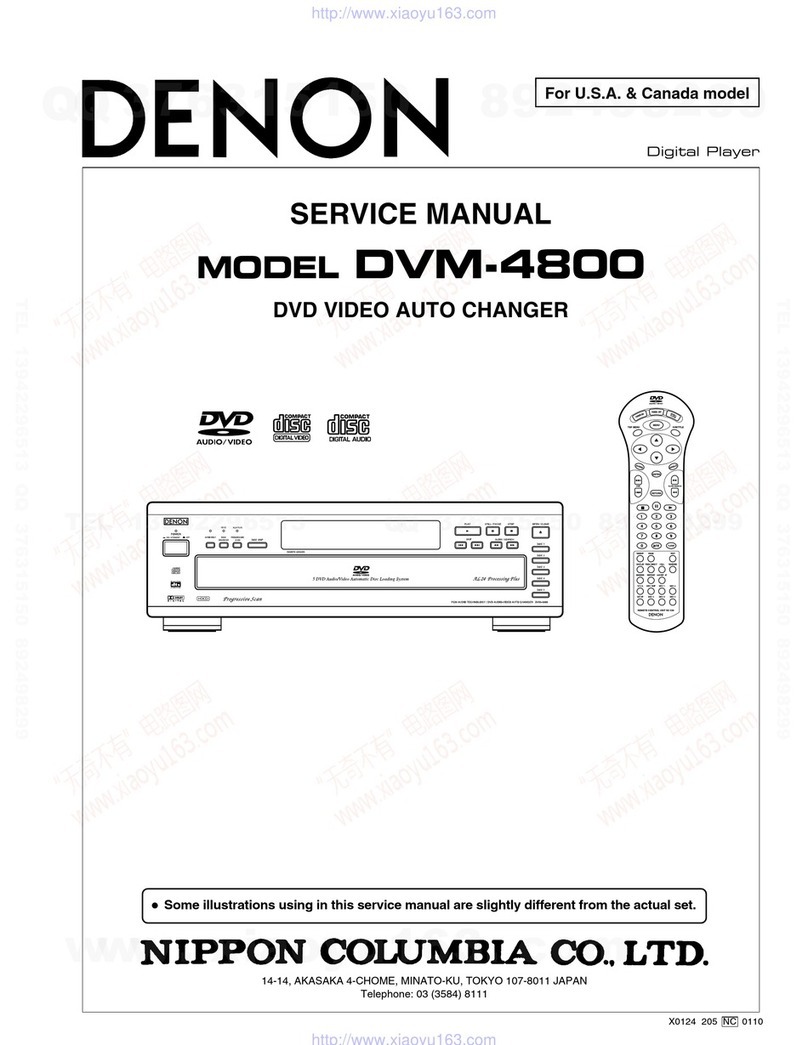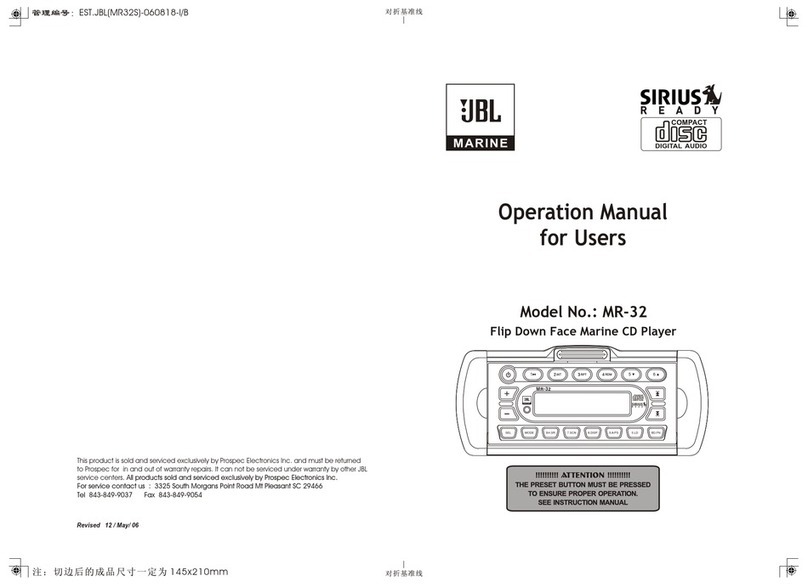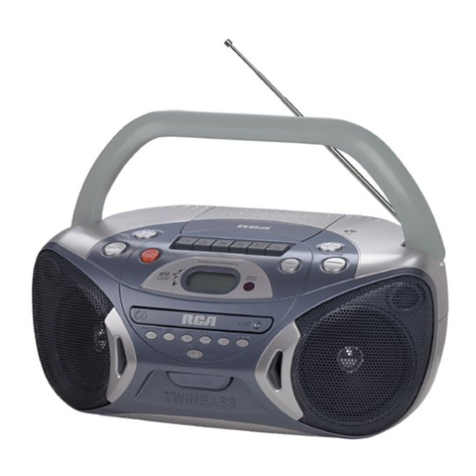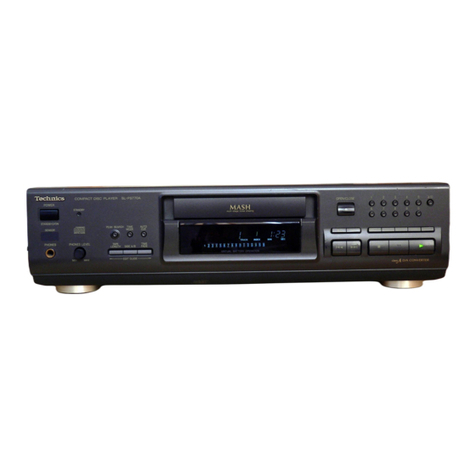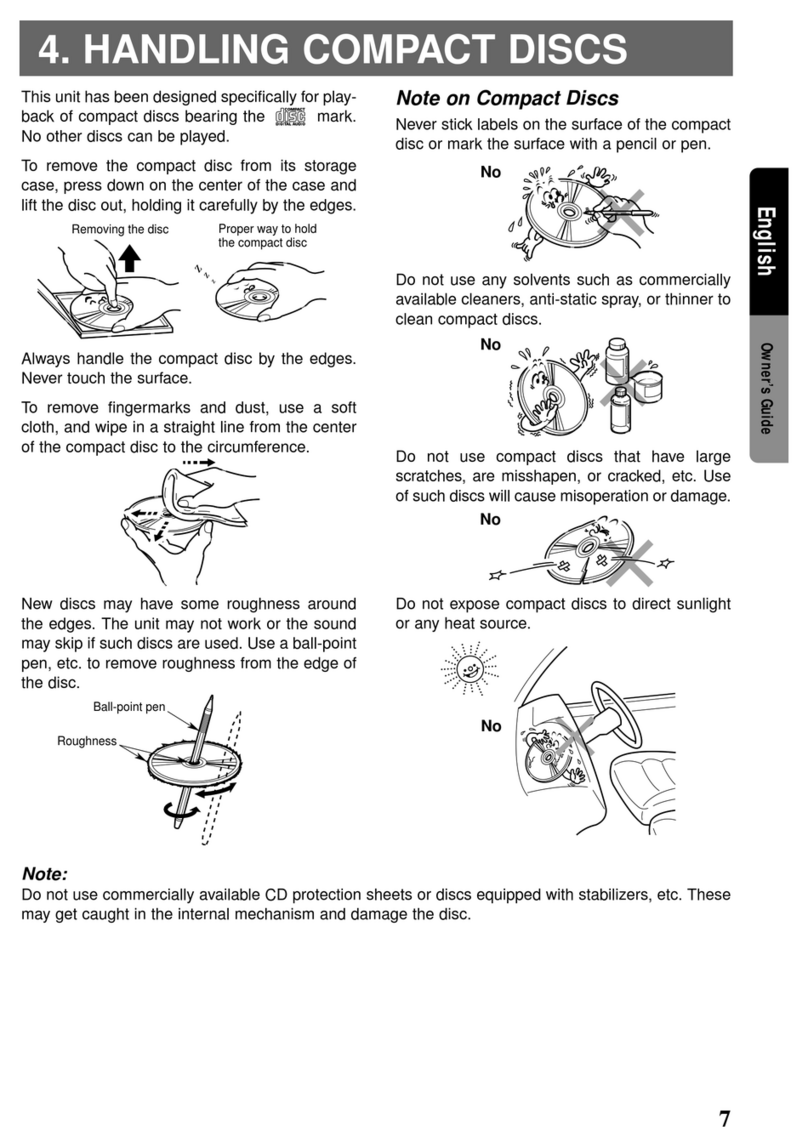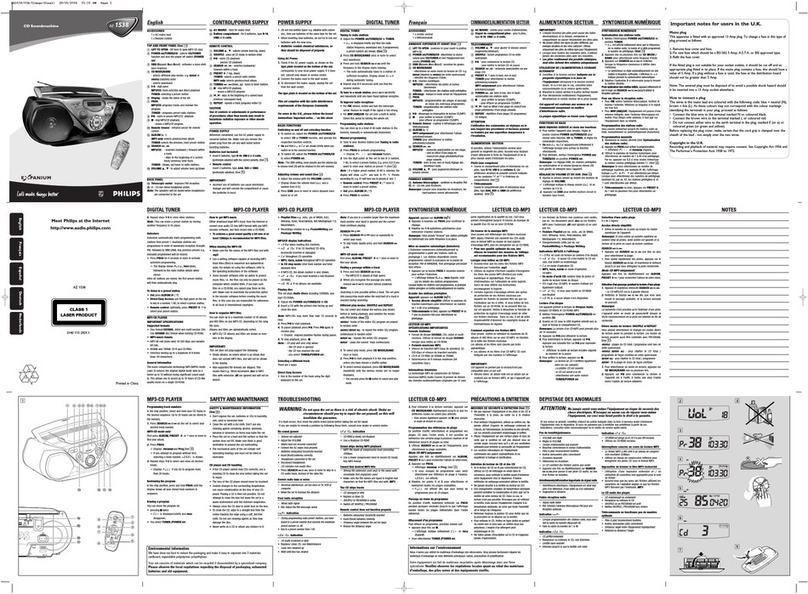
Using other funct ions
To m inimize skipping (ESP2)
The ESP (Electronic Shock Protection)
function minimize skipping by using a buffer
memory that stores music data and plays it
back in the event of a shock.
The new ESP2(ESP Squared) system uses a
new DSP (Digital Signal Processor) which can
read and store music data more efficiently,
providing a level of continuous skip
protection not found in traditional buffer
memory units. This decreases the frequency
of sound skipping and the need to utilize the
buffer memory. Use this function when
listening in a car or while walking.*
* Although ESP2provides excellent protection
against skipping, it will not prevent skipping
while jogging or running.
Press ESP.
The ESP indication appears.
To release the ESP function, press ESP again.
Notes
• Playing may stop when the player gets a strong
shock even with the ESP function on.
• You may hear a noise or sound skip when:
— listening to a dirty or scratched CD,
— listening to an audio test CD or,
— the player receives continuous shock.
• Sound may drop for a while if you press ESP
during play.
• When you use an optical digital connecting
cord, the ESP function will be disabled.
To enjoy m ore pow erful bass sound
(Sound f unction)
You can enjoy a powerful bass-boosted sound.
Press SOUND to select “MB (Mega Bass)” or
“GRV (Groove).” “GRV” is more effective.
Note
• If the sound is distorted when emphasizing
bass, turn down the volume.
To lock the but t ons
You can lock your player against any
accidental operations.
You can still operate the player with the
remote control.
Slide HOLD in the direction of the arrow.
When you press any button, “Hold” appears in
the display and you cannot operate the player.
To unlock, slide HOLD back.
DC IN 4.5 V
AC power adapt or
to a wall outlet
Polarity of the plug
zPow er Sources
Using rechargeable
batteries
Charge the rechargeable batteries before
using them for the first time.
Use the NH-DM2AA or NC-DMAA
rechargeable batteries for this player. You
cannot use any other rechargeable batteries.
1Open the lid of the battery compartment.
2Insert two rechargeable batteries by
matching the ‘and ’to the diagram
inside the battery compartment and close
the lid.
3Connect the AC power adaptor.
The indication “CHG” lights up. Charge
for about 4 hours.
(If the battery has been already charged,
“CHG“ and flash. )
4When fully charged, “CHG” disappears.
Disconnect the AC power adaptor.
To t ake out t he rechargeable
batteries
Take out the batteries in the proper way as
illustrated inside the lid or shown below.
When t o charge the rechargeable
batteries
When the rechargeable batteries become
weak, indication appears in the display.
If the “Lo ba ” appears in the display,
charge the rechargeable batteries, because the
batteries are used up.
To keep the original battery capacity for a
long time, recharge the batteries when the
batteries are used up (discharged).
When carrying the rechargeable
battery
Make sure to use the supplied battery
carrying case.
If you carry the rechargeable battery with a
metal object, short circuit, smoke or fire may
occur.
(rear)
Notes
• Charging time varies depending on how the
rechargeable battery is used.
• If the battery is new or has not been used for a
long time, it may not be charged completely
until you charge and discharge it several times.
• If the battery life becomes shorter by about
half, replace it with Sony NH-DM2AA/NC-
DMAA rechargeable battery. Do not use any
other rechargeable battery.
Using dry batteries
Insert the batteries properly in the same way
as the rechargeable batteries.
1Disconnect the AC power adaptor and
open the lid of the battery compartment.
2Insert two LR6 (size AA) alkaline
batteries by matching the ‘and ’to the
diagram inside the battery compartment
and close the lid.
Note
• Do not use manganese batteries for this player.
To t ake out t he dry batteries
Take out the batteries properly in the same
way as the rechargeable batteries.
When t o replace t he dry batteries
When the battery becomes weak,
indication appears in the display. If the
batteries are used up, “Lo ba ” appears in
the display. Replace all the batteries with new
ones.
Notes
• Do not charge the dry batteries.
• Do not mix new batteries with old ones.
• Do not use different types of batteries together.
• When the batteries are not to be used for a long
time, remove them.
• If the battery leakage occurs, wipe off any
deposit in the battery compartment, and install
new batteries.
Battery life (approx. hours) (EIAJ* )
Battery life varies depending on how the
player is used.
When using ESP function
off on
Two NH-DM2AA 13 12
(charged for
about 4 hours**)
Two NC-DMAA 8 7
(charged for
about 4 hours**)
Two Sony alkaline 23 21
batteries LR6SG
*Measured value by the standard of EIAJ
(Electronic Industries Association of Japan)
(When you use the player on a flat and stable
place; When you do not use the optical digital
connecting cord)
**Charging time varies depending on how the
rechargeable battery is used.
How to at t ach t he battery
compart m ent lid
If the battery compartment lid is detached by
an accidental drop, excessive force, etc.,
attach it as illustrated in the numbered order.
zAdditional Information
Precautions
On safet y
• Should any solid objects or liquid fall into the
player, unplug it and have it checked by
qualified personnel before operating it any
further.
• Do not put any foreign objects in the DC IN
4.5 V (external power input) jack.
On pow er sources
• When you are not using the player for a long
time, disconnect all power sources from the
player.
On the AC pow er adaptor
• Use only the supplied AC power adaptor. If
your player is not supplied with it, use AC-
E45HG AC power adaptor. Do not use any
other AC power adaptor.
• To unplug the AC power adaptor from the
wall outlet, grasp the adaptor itself, do not pull
its cord.
On dry and rechargeable bat t eries
This player is designed so that it cannot charge
any other rechargeable batteries or dry batteries
for safety reasons.
Rechargeable bat teries NH-DM 2AA/NC-DM AA
Other rechargeable bat t eries or dry batt eries
When you replace the rechargeable batteries
with new ones, make sure to use the NH-
DM2AA/NC-DMAA rechargeable batteries.
• Do not throw the batteries into fire.
• Do not carry the batteries with coins or other
metallic objects. It can generate heat if the
positive and negative terminals of the battery
are accidentally contacted by a metallic object.
• Do not mix rechargeable batteries with dry
batteries.
On the player
• Keep the lens on the player clean and do not
touch it. If you do so, the lens may be
damaged and the player will not operate
properly.
• Do not put any heavy object on top of the
player. The player and the CD may be
damaged.
• Do not leave the player in a location near heat
sources, or in a place subject to direct sunlight,
excessive dust or sand, moisture, rain,
mechanical shock, unleveled surface, or in a car
with its windows closed.
• If the player causes interference to the radio or
television reception, turn off the player or
move it away from the radio or television.
• Do not wrap the player in a cloth or blanket
during use as it may cause malfunction or
serious accidents.
On headphones/earphones
Road safety
Do not use headphones/earphones while
driving, cycling, or operating any motorized
vehicle. It may create a traffic hazard and is
illegal in some areas. It can also be potentially
dangerous to play your headsets at high volume
while walking, especially at pedestrian crossings.
You should exercise extreme caution or
discontinue use in potentially hazardous
situations.
Preventing hearing damage
Avoid using headphones/earphones at high
volume. Hearing experts advise against
continuous, loud and extended play. If you
experience a ringing in your ears, reduce volume
or discontinue use.
Caring for others
Keep the volume at a moderate level. This will
allow you to hear outside sounds and to be
considerate to the people around you.
M aintenance
To clean t he lens
Clean the lens with a lens cleaning kit KK-DM1.
To clean t he casing
Use a soft cloth slightly moistened in water or a
mild detergent solution. Do not use alcohol,
benzine or thinner.
Troubleshooting
Should any problem persist after you have made
these checks, consult your nearest Sony dealer.
The CD does not play or “no dlSC”
appears in t he display though a CD
is placed in t he player.
mThe CD is dirty or defective.
mInsert the CD with the label side up.
mMoisture condensation has occurred.
Leave the player aside for several hours
until the moisture evaporates.
mThe lens is dirty.
mClose the lid of the player and the battery
compartment firmly.
mMake sure the batteries are inserted
correctly.
mConnect the AC power adaptor to a wall
outlet securely.
When you press ^, “00” appears in
the display f or a mom ent , and
disappears. The CD does not play.
mRechargeable battery or dry batteries are
used up. Charge the rechargeable battery
or replace dry batteries with new ones.
No sound, or noise is heard.
mConnect the plugs firmly.
mPlugs are dirty. Clean the plugs with a dry
soft cloth periodically.
“Hl dc ln” appears in t he display.
mUse only the supplied AC power adaptor
or AC power adaptor AC-E45HG (not
supplied).
mUse only the car battery cord listed in the
optional accessories.
“Hold”
appears in t he display w hen
you press a button.
mThe buttons are locked. Slide HOLD back.
“Lo ba ”
appears in t he display
w hen you press a but t on.
mThe rechargeable batteries are used up
completely. Connect the AC power
adaptor and charge the batteries.
mThe dry batteries are use up. Replace them
with new ones.
The battery life is short .
mManganese batteries are used. Use alkaline
batteries.
mReplace the batteries with new ones.
The volume is lim ited t o a certain
level even if you at t empt to turn it
up.
mAVLS selector is set to LIMIT. Set it to
NORM.
mThe earphones are connected to the LINE
OUT jack. Connect them to the 2/
REMOTE jack.
During recording w it h opt ical
digital connect ion, the t rack num ber
cannot be recorded correct ly.
mRecord the track number again using the
MiniDisc recorder, DAT recorder, etc.
mRecord again according to the procedure
shown in the section “Connecting to other
stereo equipment.”
Specifications
CD player sect ion
System
Compact disc digital audio system
Laser diode properties
Material: GaAlAs
Wavelength: λ = 780 nm
Emission duration: Continuous
Laser output: Less than 44.6 µW (This output
is the value measured at a distance of 200 mm
from the objective lens surface on the optical
pick-up block with 7 mm aperture. )
Error correction
Sony Super Strategy Cross Interleave Reed
Solomon Code
D-A conversion
1-bit quartz time-axis control
Frequency response
20 - 20,000 Hz +1
–2 dB (measured by EIAJ CP-
307)
Output (at 4.5 V input level)
Headphones (stereo minijack)
Approx. 15 mW + approx. 15 mW
at 16 ohms
Line output (stereo minijack)
Output level 0.7 V rms at 47 kilohms
Recommended load impedance over 10
kilohms
Optical digital output (optical output connector)
Output level: –21 - –15 dBm
Wavelength: 630 - 690 nm at peak level
General
Pow er requirement s
For the area code of the model you purchased,
check the upper left side of the bar code on the
package.
• Two Sony NH-DM2AA rechargeable
batteries: 2.4 V DC
Two Sony NC-DMAA rechargeable
batteries: 2.4 V DC
• Two LR6 (size AA) batteries: 3 V DC
• AC power adaptor (DC IN 4.5 V jack):
U2/CA2/E92 model: 120 V, 60 Hz
CED/CEX/CET/EE1/E13 model:
220 - 230 V, 50/60 Hz
CEK model: 230 - 240 V, 50 Hz
EA3 model: 110 - 240 V, 50/60 Hz
AU2 model: 240 V, 50 Hz
JE.W/E33 model: 100 - 240 V, 50/60 Hz
HK2 model: 220 V, 50/60 Hz
CN2/AR1 model: 220 V, 50 Hz
• Sony DCC-E245 car battery cord for use on
car battery: 4.5 V DC
Dimensions (w / h/ d) (w it hout projecting parts
and controls)
Approx. 131.8 ×23.9 ×142.0 mm
(5 1⁄4×31⁄32 ×5 5⁄8in.)
M ass (w ithout rechargeable batteries)
Approx. 200 g (7.0 oz)
Operating temperature
5°C - 35°C (41°F - 95°F)
Supplied accessories
For the area code of the model you purchased,
check the upper left side of the bar code on the
package.
D-E771
AC power adaptor (1)
Headphones (1)
D-E776CK
AC power adaptor (1)
Headphones (1)
Car battery cord (1)
Car connecting pack (1)
Velcro tape (2)
Spare fuse (1)
Spiral tube (1)
Design and specifications are subject to change
without notice.
For US customers
AC power adaptor supplied is not intended to be
serviced. Should the AC power adaptor cease to
function in its intended manner, during the
warranty period, the adaptor should be returned
to your nearest Sony Service Center or Sony
Authorized Repair Center for replacement, or
after warranty period, it should be discarded.
Opt ional accessories
Car connecting pack CPA-9
Car battery cord with car connecting pack
DCC-E26CP
Car battery cord DCC-E245
Active speaker system SRS-A21, SRS-A41,
SRS-A71
Rechargeable battery NH-DM2AA,
NC-DMAA (2P)
Connecting cord RK-G129HG
Optical digital connecting cord POC-5B, POC-
10B, POC-15B, POC-5AB, POC-10AB, POC-15AB
AC power adaptor AC-E45HG
Stereo headphones MDR-35, MDR-E848LP
Your dealer may not handle some of the above
listed accessories. Please ask the dealer for
detailed information about the accessories in
your country.
LINE IN or
REC IN
Stereo system,
casset t e recorder,
radio casset t e
recorder, et c.
Lef t (w hit e)
Right (red)
LINE OUT
(OPTICAL)
Using t he optical digit al
connecting cord
MiniDisc recorder
DAT deck, et c.
OPTICAL
(DIGITAL) IN*
LINE OUT
(OPTICAL)
Opt ical digit al
connecting cord
POC-5B
(not supplied)
(rear)
(rear)
To protect your hearing (AVLS)
The AVLS (Automatic Volume Limiter
System) function keeps down the maximum
volume to protect your ears.
Set AVLS to LIMIT.
The AVLS indication appears.
Note
• If you use the SOUND function and the AVLS
function at the same time, sound may be
distorted. If this happens, turn down the
volume.
To resum e playing f rom t he point
you st opped t he CD (Resume Play)
Normally, every time you stop and play,
playing starts from the beginning of the CD.
The resume play function, however, lets you
listen to from the point at which you last
turned off the player.
Set RESUME to ON.
To cancel resume play, set RESUME to OFF.
Notes
• Even if RESUME is set to ON, playing starts
from the beginning when you open the lid.
• The resume point may be inaccurate by about
30 seconds.
To t urn off the beep
You can turn off the beep that sounds as you
operate your player.
Disconnect the power source (AC power
adaptor, rechargeable battery or alkaline
batteries). While you press and hold down p,
connect the power source again. To make the
beep sound again, disconnect the power
source, and then connect it without pressing
p.
Connecting to ot her
stereo equipment
You can listen to the CD through other stereo
equipment or record a CD on a cassette tape or
a MiniDisc. Refer to the instruction manual of
the other equipment for details. Before making
connections, turn off each piece of equipment.
Using t he connecting cord
Note
• When you use a connecting cord, the SOUND
function will be disabled.
*If the OPTICAL (DIGITAL) IN jack is square-
shaped, use the POC-5AB optical digital
connecting cord instead.
Notes on connecting to other stereo
equipment
• Before you play the CD, turn down the volume
of the connected equipment so as not to
damage the connected speakers.
• The beep sound is not output from the LINE
OUT (OPTICAL) jack.
• When you connect other equipment to the
LINE OUT (OPTICAL) jack of this player,
adjust the volume on the connected equipment.
• When you record a CD on a cassette tape using
a tape recorder that has the blank search
function, release the ESP function. If the ESP
function is on, the blank search function does
not work.
• Use the AC power adaptor for recording. If
you use the rechargeable batteries or dry
batteries as a power source, batteries may
become weak during recording.
Recording w it h opt ical digital
connection
Record a CD on a MiniDisc, DAT, etc., according
to the following procedure.
1Press ^on the player to start play.
2Press ^again to pause.
3Press =/+to select the track you want to
record.
4Press r(record) on the MiniDisc recorder,
DAT recorder, etc.
5Press ^on the player to release pause.
Notes
• Connect the optical digital connecting cord
while the player is in stop mode.
• If you record without pausing the player, some
CD may have problem with recording the first
track number correctly.
• The SOUND function works on the output
from the 2/REMOTE jack, but does not work
on that from the LINE OUT (OPTICAL) jack.
• When use an optical digital connecting cord,
the ESP function will be disabled.
Playing a CD in a car
You can use your player in a car by
connecting it to the car cassette deck.
You cannot use the car mount plate for this
player.
When you use the player in a car, install it
securely in a location which does not interfere
your driving.
To connect your player to a car cassette deck,
you need the following accessories:
• Car connecting pack CPA-9
• Car battery cord DCC-E245
or,
• Car battery cord with car connecting pack
DCC-E26CP
Refer to the instruction manual of each
accessory for details.
Notes
• Do not put the player on the dashboard.
• Do not leave the player in a car parked under
sunlight.
• Use a Sony car connecting pack for reducing
noise.
• Use only the car battery cord listed in the
optional accessories. If you use any other car
battery cord, smoke, fire or malfunction may
occur.
Sw itched ignition function
(w hen using the car battery cord)
With this feature, your player stops
automatically when you turn off the engine of
the car. (This function is not possible with
some cars depending on the model).
Connecting cord
RK-G129HG
Lens
ESP
SOUND
Downloaded from: https://www.usersmanualguide.com/
